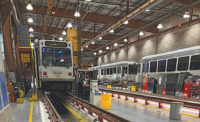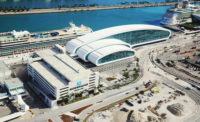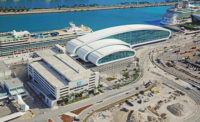Port of Juneau Cruise Ship Berths
Juneau, Alaska
Best Project
Owner: City and Borough of Juneau
Lead Design/Civil/Structural/MEP Firm: PND Engineers Inc.
General Contractor: Manson Construction Co.
Pontoon Design: Concrete Technology Corp.
Juneau’s remote seaside location and harsh environment posed construction challenges for the team building the Port of Juneau Cruise Ship Berths in the Gastineau Channel. Despite the project’s complexity, which included underwater work and extreme conditions, construction was completed with zero safety incidents.
The $53.8-million project included two independent, floating concrete pontoon berths connected to four pile-supported structures, or dolphins. A structural steel frame is connected to embeds in each pontoon, forming a ring around the piling that allows the pontoon to move vertically with the tide.
The site’s ground conditions ranged from loose marine sediment to shallow and steep-sloping bedrock. The terrain posed both engineering and safety challenges, says Monica Blanchard, project manager for Manson Construction Co. In all, 179 piles were installed to support four pontoon dolphins and 13 mooring and breasting dolphins.
“Typically, you’re able to drive the piles with a vibratory hammer through the overburden,” Blanchard says, referring to the rock and material overlaying the site’s bedrock. “Many places have 100 feet of overburden, and the piles stay in place.”
At the Juneau site, however, some piles were installed in areas with only 5 to 10 ft of overburden, Blanchard says. “And even in areas with enough overburden, some of the rock wasn’t competent enough to support the piles. You worried that if you just let it go, the piles would all fall over.”
The solution was to anchor those piles into bedrock. The dolphins required temporary structural steel templates to position the permanent piles during construction. In one location, Manson developed an underwater steel frame installed near the bedrock surface to stabilize each pile and allow seating and subsequent socket drilling. Workers used a hydraulically operated man lift attached to a barge during installation of the concrete floats and pile-driving and welding operations.
“This way we didn’t have to suspend them from a crane in a basket. It allows (crews) to be closer to the work and safer because they’re more secure attached to a stable barge as opposed to a crane,” Blanchard says.
Workers also wore fall protection gear while working on the dolphins, Blanchard says. “Juneau has a 20-ft tide swing every day. At one time, workers have their feet in water and a few hours later, a 15-ft (potential) fall.”
The team worked with suppliers in the Seattle-Tacoma area to prefabricate many components. Piles were spliced to the longest lengths possible, concrete pontoons were finished and steel was welded and painted. This minimized the amount of concrete and welding performed in the cold, windy and wet weather and allowed workers to finish ahead of schedule during both seasonal construction “windows.”
Related Article: Top Projects Reflect Innovation, Creativity








Post a comment to this article
Report Abusive Comment